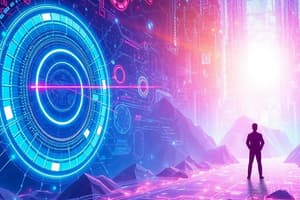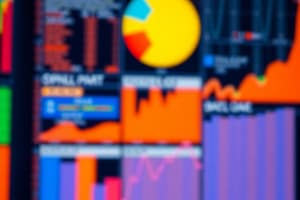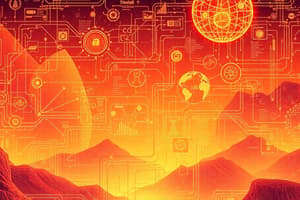Podcast
Questions and Answers
What is the activity of gathering and capturing raw data referred to as?
What is the activity of gathering and capturing raw data referred to as?
- Input (correct)
- Processing
- Feedback
- Output
What is the primary purpose of feedback in an Information System?
What is the primary purpose of feedback in an Information System?
- To revise and rebuild future systems
- To monitor and control operations (correct)
- To provide useful information to users
- To convert data into useful outputs
What type of Information System relies on manual processes, such as drawing charts and trend lines, to assist in making decisions?
What type of Information System relies on manual processes, such as drawing charts and trend lines, to assist in making decisions?
- Manual-based Information System (MBIS) (correct)
- Decision Support System (DSS)
- Management Information System (MIS)
- Computer-based Information System (CBIS)
What are the three elements of a Computer-based Information System (CBIS)?
What are the three elements of a Computer-based Information System (CBIS)?
What is the organized collection of facts and information, typically consisting of two or more related data files, referred to as?
What is the organized collection of facts and information, typically consisting of two or more related data files, referred to as?
What is the electronic transmission of signals for communications referred to as?
What is the electronic transmission of signals for communications referred to as?
What is the most important element in most management information systems?
What is the most important element in most management information systems?
What defines the steps to follow to achieve a specific end result, such as entering a customer order or paying a supplier invoice?
What defines the steps to follow to achieve a specific end result, such as entering a customer order or paying a supplier invoice?
What is one of the main objectives of the IS101 course?
What is one of the main objectives of the IS101 course?
What is one of the business application systems that support the functions of manufacturing?
What is one of the business application systems that support the functions of manufacturing?
What is the title of the book used in the IS101 course?
What is the title of the book used in the IS101 course?
What is one of the topics covered in the IS101 course?
What is one of the topics covered in the IS101 course?
What is the role of a systems analyst in the development of a customized computer-based information system?
What is the role of a systems analyst in the development of a customized computer-based information system?
What is the author of the book used in the IS101 course?
What is the author of the book used in the IS101 course?
What does the characteristic of accessible information ensure?
What does the characteristic of accessible information ensure?
What is the concept of 'garbage in, garbage out' related to in the context of information?
What is the concept of 'garbage in, garbage out' related to in the context of information?
What is the primary consideration for decision makers when evaluating the value of information?
What is the primary consideration for decision makers when evaluating the value of information?
What is a key characteristic of reliable information?
What is a key characteristic of reliable information?
What is the main difference between irrelevant and relevant information?
What is the main difference between irrelevant and relevant information?
Why is complete information important in decision-making?
Why is complete information important in decision-making?
What is the primary purpose of flexible information?
What is the primary purpose of flexible information?
What is the relationship between the cost of producing information and its value?
What is the relationship between the cost of producing information and its value?
Flashcards are hidden until you start studying
Study Notes
Characteristics of Valuable Information
- Information should be easily accessible by authorized users in the right format and at the right time
- Accurate information is error-free, and inaccurate information is often generated due to inaccurate data
- Complete information contains all important facts
- Economical information should be relatively inexpensive to produce
- Flexible information can be used for a variety of purposes
Learning Outcomes
- Understand the basics of computers, database, and telecommunication technology
- Address how computers can help a business
- Highlight business application systems that support functions of accounting, finance, marketing, human resource management, and manufacturing
- Differentiate between different types of information systems (ERP, CRM, EIS, DS, and Expert Systems)
- Deal with topics of e-Business and e-Commerce
- Identify the process of developing a customized computer-based information system
Information System (IS)
Functions
- Input: Gathering and capturing raw data
- Processing: Converting data into useful outputs
- Output: Production of useful information, usually in the form of documents and reports
- Feedback: Receiving ideas, impressions, and criticism from users and stakeholders to revise and rebuild the system
Roles of IS in Organizations
- Provides a feedback mechanism to monitor and control operations to achieve goals and objectives
Types of Information Systems
Manual-based Information Systems (MBIS)
- Example: Investment analysts manually draw charts and trend lines to assist in making investment decisions
Computer-based Information Systems (CBIS)
- Example: Management Information Systems that follow stock indexes and markets and suggest when to purchase or sell stocks
- Elements:
- Hardware: Computer equipment used for input, processing, and output activities
- Software: Computer programs that govern the operation of the computer
- Database: Organized collection of facts and information
- Communication, Networks, and the Internet: Electronic transmission of signals for communication
- People: The most important element in most management information systems
- Processes: Strategies, policies, methods, and rules for using the IS
Studying That Suits You
Use AI to generate personalized quizzes and flashcards to suit your learning preferences.




